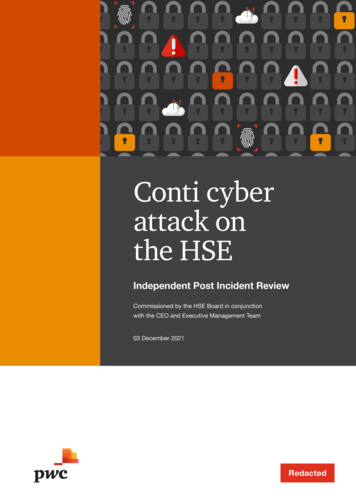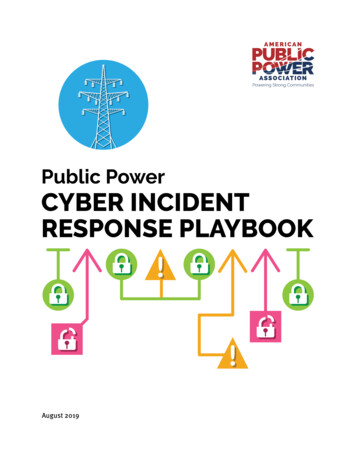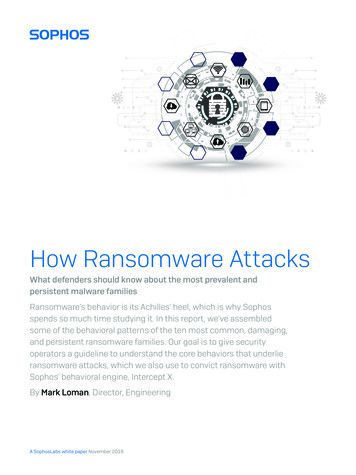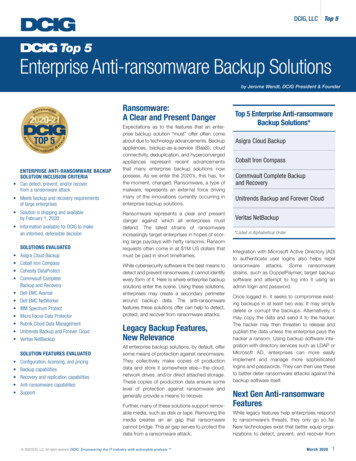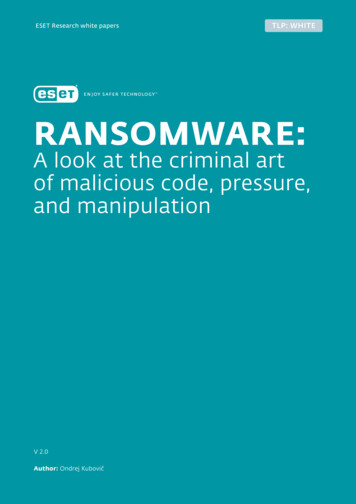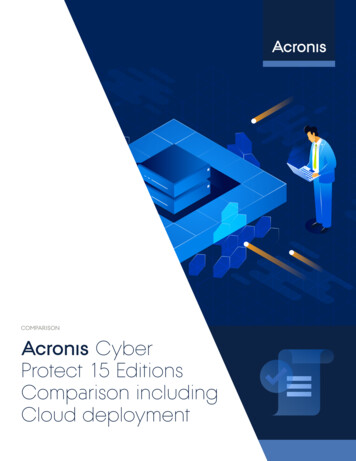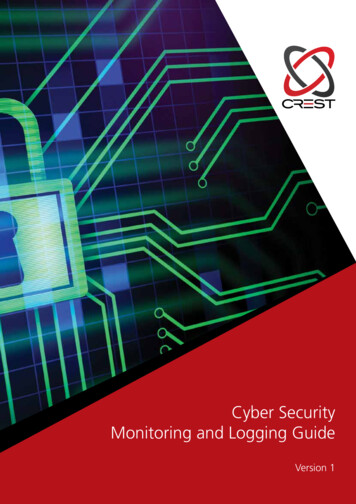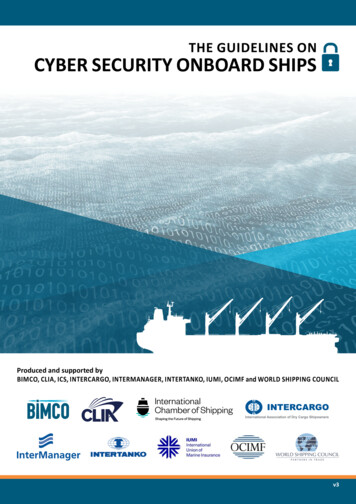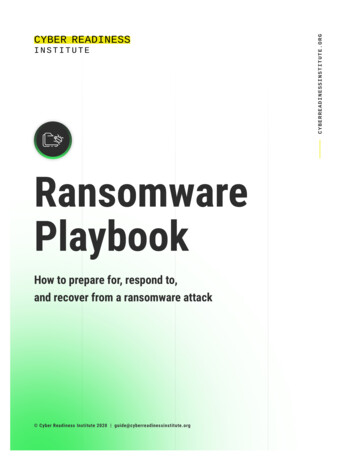
Transcription
CYBERREADINESSINSTITUTE.ORGCYBER READINESSINSTITUTERansomwarePlaybookHow to prepare for, respond to,and recover from a ransomware attack Cyber Readiness Institute 2020 TITUTE.ORGguide@cyberreadinessinstitute.org
By 2021“every 11 seconds”a new organization willfall victim to ransomware,according to market researcherCybersecurity Ventures.1Ransomware PlaybookTo Pay or Not to Pay? This question is often the first one many organizations considerafter they are hit with a ransomware attack.Unfortunately, the choice is not simple. Many organizations simply don’t know how toprotect against ransomware. This guide is intended to provide a roadmap for organizations(e.g., small and medium-sized businesses, state and local governments) to securethemselves against this growing NSTITUTE.ORGguide@cyberreadinessinstitute.org
All organizations are at risk of having their valuable data – about customers,employees, operations – encrypted by a malicious actor so that the organizationloses access to it. A ransomware attack is conducted by a malicious actorto hold an organization’s data hostage for a ransom. Malicious actors can gainaccess to an organization’s data through various means, including phishingand unpatched software. Patches are issued by software companies forvulnerabilities they find in their programs; many users fail to download thepatches, which means the vulnerabilities can be exploited.An organization that builds a culture of cyber readiness can be resilient againsta ransomware attack by taking preventative actions (e.g., creating a backup ofcritical data) and developing and testing a ransomware incident response plan.An organization should focus on three steps: Prepare, Respond, and Recover.STEP 1PrepareCYBERREADINESSINSTITUTE.ORGSTEP 2RespondSTEP 3Recoverguide@cyberreadinessinstitute.org
PrepareMake sure your company regularly backs up its data;storing dating in the cloud is a common tool used forbackups. If your employees save important businessinformation on their own computers, your organizationshould also provide clear instructions to your employees onhow to back up their data on a regular basis. Key elementsto protect against ransomware include: ince malicious actors often use phishing toSinfect a system with ransomware, it is crucial tohave a phishing policy. Conduct routine phishingtests so employees will be able to detect aphishing email before clicking on any dangerouslinks or attachments and, when possible, use ananti-phishing software program. Prioritize the data that is most critical to yourorganization and back it up. Make sure you canre-install from the backups, which are often inthe cloud, and that the backups aretested frequently. pdate your software with the latest securityUpatches. This critical preventative step willmake it harder for malicious actors tocompromise your system. Early detection is important, so make sure yourworkforce knows how to report a possible ransomwareincident or unusual network behavior. Contract, if possible, with a vendor that can provideresponse support if an incident occurs. Establish acontract, pre-event, so you have accessto the vendor immediately. evelop an organization-wide policy regardingDransomware attacks. It is much easier to havethese discussions when the pressure of responseis not looming. Questions to consider:What data is most critical to yourorganization? Does your insurance coverransomware? Are you OK with paying aransom? If so, do you understand how touse bitcoin and other crypto-currencies?Discuss and agree to an organization-wide policy regarding ransomware attacks.It is much easier to have these discussions when the pressure of responseis not inessinstitute.org
Is the data critical to your operations?Has your organization pre-determinedthat it is ok paying a ransom?Does your insurance coverransomware?RespondIf an employee or the organization is confronted with a ransom request, your organizationmust first assess the legitimacy of the ransom request by contacting your IT manager. If it is legitimate,two possible scenarios are presented:1 our organization has backups that work.YYou don’t need to worry about the ransomware.You restore your data completely and get back to work.2 ata that is held hostage is needed and there areDno working backups.a.Check if the data exists somewhere else in the organization(e.g., cache files, email) so you can “tape” together the data to replace what is being held hostageb. If you can’t access the data elsewhere, ask the following questions: Is the data critical to your operations? Has your organization pre-determined that it is ok paying a ransom? Does your insurance cover institute.org
RecoverThe fire is out and it’s time to return to business as usual.The scope of the ransomware attack and the severity ofits impact on your daily operations will determinehow much time and effort is needed to recover.Use the incident as a learning experience to reinforcethe importance of cyber readiness principles likepatching and phishing awareness.Ensuring that your software is always updated with thelatest security patches will make it harder to penetrateyour system. Likewise, enforcing routine phishing trainingminimizes human error and the potential entry pointsinto your system. As with any security breach, notify allaffected parties, re-set the user IDs and passwords of allcompromised devices, update the software on all devices,and re-install your data from backups once the ransomwarethreat has been neutralized.It is especially important to ensure patches areupdated following the attack. If data has been restored,sometimes vulnerabilities that were patched,pre-ransomware, can reappear.The Cyber Readiness Program includes detailedinstructions and templates to help you create your ownpolicies and incident response plan to prepare for,respond to, and recover from a ransomware attack.Sign up for free at BeCyberReady.com.To read about real examples of how companies andmunicipalities responded to a ransomware attack,please visit Cyber Readiness News.The Cyber Readiness Program includes detailed instructions and templatesto help you create your own policies and incident response plan to prepare for,respond to, and recover from a ransomware nessinstitute.org
Ransomware Decision GuideHave you prioritized your data and systems so you know what is most critical to your business operations? Do you have an incident response plan that covers ransomware?PREPARE Identify what is most valuable. Go to BeCyberReady.comto access a prioritization checklist. Do you have a current backup? Back up your systemand all data.Have you tested it inthe last month? Develop an incident response plan that covers ransomware. Go toBeCyberReady.com to access an incident response plan template. Congratulations.You’re prepared. Test your backup to make sureyou can recover your data –especially the most critical toyour business operations.You better hope you don’t get a ransomware attack.You are REALLY unprepared. Ransomware Incident Occurs Isolate the incident and remove the infected computer(s) from the network. Then proceed. Great job.Go directly to Recover!Do you have an IT supportto contact?RESPOND Does your policy cover ransom events? Is the data being held hostage valuable to your business?Can you or your IT supportback up in real time? Do you have cyber insurance? Your data is unrecoverable decide whether or not to pay.Go into the real time backup and clean out the malware.RECOVERReset user IDs and change passwordsDo a clean install from your backupUpdate your softwareSelectively reinstall dataCYBERREADINESSINSTITUTE.ORGYou are back in business!!Sign up for the free Cyber ReadinessProgram at BeCyberReady.comto prevent more ransomwareattacks in the future.guide@cyberreadinessinstitute.org
the importance of cyber readiness principles like The Cyber Readiness Program includes detailed patching and phishing awareness. Ensuring that your software is always updated with the latest security patches will make it harder to penetrate y

